This is a Leidolf Lordomat interchangeable lens 35mm rangefinder camera made by the Leidolf company out of Wetzlar, Germany around 1953. Wetzlar was home to Leitz who made the famous Leica camera. Leidolf originally started as a subcontractor of Leitz making microscopes and binoculars. Their foray into building their own cameras lasted less than 15 years before the company went out of business. The Lordomat was the company’s first mid-range rangefinder and saw moderate success in Europe during the 1950s.
Film Type: 135 (35mm)
Lens Mount: Leidolf Breech Mount
Lens: 50mm f/2.8 Leidolf Wetzlar Lordonar 4 elements
Focus: 3′ 6″ to Infinity
Type: Coupled Rangefinder
Shutter: Prontor SVS MXV leaf
Speeds: B, 1 – 1/300 seconds
Exposure Meter: None
Battery: None
Flash Mount: M, X, and V PC Sync
Manual: http://www.cameramanuals.org/pdf_files/lordomat_standard.pdf
History
 The word “Lordo” in Italian means filthy or gross. It is a good thing Leidolf was a German company and not based out of Italy, otherwise this might be a pretty icky camera! In reality, quite the opposite is true. The Leidolf Lordomat is a very nicely designed and compact 35mm rangefinder.
The word “Lordo” in Italian means filthy or gross. It is a good thing Leidolf was a German company and not based out of Italy, otherwise this might be a pretty icky camera! In reality, quite the opposite is true. The Leidolf Lordomat is a very nicely designed and compact 35mm rangefinder.
As was typical of German made cameras of the era, the Lordomat was a well built and sturdy camera that has stood the test of time. Many examples that survive to this day generally are in good working order assuming they were taken care of. Being built in the same town as the highly regarded Leica camera, I am sure comparisons were made back when this camera was sold new. I would assume this was considered to be a “poor mans Leica” by those who wanted quality German engineering at a discount price.
Although these are well built cameras, they didn’t seem to sell well. Maybe Leitz had such a stronghold on German built rangefinders, or maybe there was poor leadership at Leidolf, or maybe even no one wanted a “poor man’s Leica”. We’ll probably never know, because Leidolf went out of business in 1962.
This is the “History” section of this review, so I guess I am getting off track here, but frankly, there isn’t a lot of information about Leidolf out there. What little I could find says that Leidolf was formed in Wetzlar by Rudolf Leidolf in 1921. They originally were an optics company making lenses for microscopes and binoculars.
Wetzlar is a relatively small town in central Germany. According to Wikipedia, its population in 2013 was 51,135. I imagine that was quite a bit less in the 1920s. Being in the same town as Leitz who was already a world-renowned maker of quality cameras, it is entirely plausible that the two companies had some sort of relationship. There is a very good chance that Mr. Leidolf or some of his employees may have worked for Leitz at some time, but there isn’t a whole lot of information out there other than one comment that Leidolf subcontracted some non-camera production like microscopes and binoculars from Leitz.
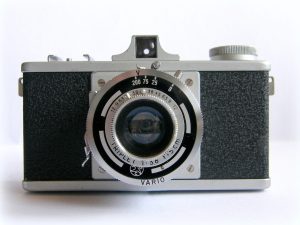
For it’s first 2 decades and right after the conclusion of World War II, Leidolf continued to make optics for other products, but sensing a demand for more German built cameras, it released the Leidox I, a 127 roll film camera in 1949. Leidolf’s first models were very basic viewfinder cameras that had basic triplet lenses and a 3 speed Vario shutter. In 1952, the Leidox was redesigned to accept 35mm 135 format film. With the change to 35mm film, the name changed to the Lordette. Despite 35mm film being physically smaller than 127 format roll film, the Lordette was built using the same body as the Leidox, meaning that there was unused space near the bottom of the camera.
The Lordette continued to see advancements in 1953 and 54, eventually being renamed once again to Lordox and Leidolf IIS. These models had faster f/2.8 4-element lenses with Prontor S and Prontor SV shutters.
I can’t find any information about production numbers for these earlier models, but they obviously sold well enough that Leidolf saw the need for a much more sophisticated rangefinder model, and in 1953 an all new body was created for the Lordomat which had a coupled rangefinder and breech-lock interchangeable lens mount.
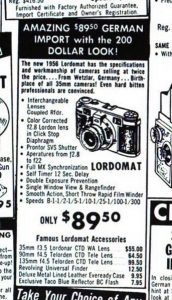
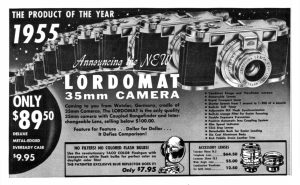
The Lordomat could not compare in terms of prestige to the Leica cameras of the day, but the Lordomat was a very well built camera that offered a lot of the quality of a Leica for significantly less. The ad to the left, from the March 1956 issue of Popular Photography, lists the Lordomat for $89.50, which is significantly less expensive than any Leica model from the same era.
The body is made of solid brass and is coated in a nice textured leatherette. The camera was compact and light weight and it’s rangefinder had an unusually long 65mm base which meant it could have a higher degree of accuracy compared to shorter base rangefinders.
Although usually equipped with the 50mm f/2.8 Lordonar lens, there were 4 other lenses available. A 50mm f/1.9 six-element lens, a 35mm f/3.5 Travenor, a 90mm f/4 Travenor, and a 135mm f/4 Travenor. Although all of the lenses were designed by Leidolf, their construction was outsourced to other companies. The lens mount was a proprietary breech mount design which would mount in a notch on the camera body, and then an external ring would screw into the body securing the lens to the camera. Perhaps it was this unique lens mount that was the Achilles Heel of the Lordomat since it could not take advantage of the growing number of M39 lenses which were made for Leica screw mount cameras.

The Lordomat went through at least 2 subtle revisions during its production run. Earlier models had a red-tinted rangefinder patch which disappeared sometime around serial number 59,000. Then somewhere around serial number 100,000 two body mount strap lugs were added to the front corners of the camera.
The Lordomat was in production for only a couple of years, before it was replaced by the Lordomat C35 in 1956 which had an added on Selenium light meter on top of the camera. In my opinion, the added light meter gave the camera a slight resemblance to the Contax III / Kiev 4 rangefinders made by Zeiss Ikon and Arsenal.
The Lordomat line of cameras continued to receive updates and more features up until around 1960, but the same basic body design from the Lordomat was retained. By the early 60s, only one or two new models would be released before the company’s closure in 1962. Aside from the obvious reason that not enough were sold, I cannot find any other information regarding why the company went out of business.
Edit 12/4/2015: After writing this review, I discovered that after Leidolf’s closure in 1962, many of its assets were bought out by the Swiss company Wild Heerbrugg, another optics company specializing in surveying instruments, microscopes and instruments for photogrammetry. In a strange twist of fate, in 1987, Wild Heerbrugg would merge with Ernst Leitz GmbH of Wetzlar. The combined company continued to make optical instruments, and then in 1990 became fully owned by the Leica Holding Company. The brand name “Wild Heerbrugg” is still in use today in several of the company’s product. Thank you PF McFarland for this information!
Edit 4/12/2017: A reader named Peter Bermes adds some additional insight as to why Leidolf went out of business. He links to a German language site that says it was a result of corporate greed from Leidolf’s retail partner. Rather than repeat what Peter has already typed up, I encourage you to read his post in the comments section at the bottom of this article.
My Thoughts / Using the Camera
The Lordomat is not a well known camera. I had never heard of, or even seen one before one randomly popped up for sale on eBay. After a bit of research, I knew I had to have one. The Lordomat was one of the more expensive cameras I’ve bought on eBay at around $35. Yes, that’s expensive for me!
Upon receiving the camera, I was pleased to see that the camera was in good working order. There were only 2 cosmetic issues, one of which was a small amount of rust on the top plate beneath the rewind knob, and the other was a strange discoloration of the clear plastic that covers the film counter. The image to the left shows my particular example and you’ll see that the frame counter has a brownish/golden color. At first, I assumed this was normal, but after looking at other Lordomats, I’ve never seen another with the tinted frame counter so this has to be a result of some type of chemical reaction. Nevertheless, everything else about the camera seemed to work OK.
Upon holding the camera, you can’t help but appreciate its svelte lines and compact, yet solid, feel. There is nothing “cheap” about this camera, and while this camera originally sold for much less than a comparable Leica, I feel that anyone who bought it considered it a great bargain.
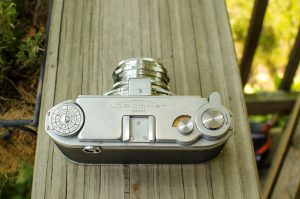
I like the look of the top plate of the camera. The name ‘Lordomat’ is proudly etched across the top plate and accented by a sweeping line above the name. The top plate features all the things you would normally expect to see on top of a camera, cold shoe, frame counter, film advance lever, and rewind knob, somehow it all feels uncluttered. As much as everyone loves the Leica, I find it’s top plate (and therefore almost all Leica copies) to be rather busy.
A second notable characteristic of the Lordomat is it’s film advance lever. The lever is very small and compact and requires two complete motions to advance one frame of film. This might seem like a hassle, but the stroke is very small and easy to move. Also, when advancing the film, the camera emits a very nice and purposeful sounding ratcheting noise, not unlike that of a clock being wound. I can’t describe it any better other than to say that this camera just “feels” good to wind. I have no other camera in my collection that sounds like the Lordomat when being wound.
The viewfinder is a coincident image single viewfinder with a beamsplitter like most rangefinders from the 1960s and beyond. Back in the 1950s, it was still pretty common for rangefinders to have a split window rangefinder, but this being a German camera designed to compete with the Leica, a single viewfinder must have been a necessity to remain competitive in the market. This puts it in rare company with my Aires 35-III L as being the only two 1950s rangefinders with a coincident image rangefinder.
Compared to more modern cameras, the rangefinder patch is a bit dim. I am not sure if this is a result of age, or if this was how it was originally. Once again, comparing it to my Aires, they’re very similar, so I am just going to guess this is just how they were. Thankfully, when I received my Lordomat, the viewfinder was already very clean, so there was no need for me to open it up, but I might still do that one day just to make sure it is as clean as possible.
The camera supports both M and X flash synchronization, it has a shutter cable release socket for long exposures, and it has double exposure protection to eliminate any chance of accidentally double-exposing an image.
The frame counter on top of the camera does not automatically reset to 0 when new film is loaded, so you have to remember to set it to the black triangle mark in between 36 and 0 on the frame counter before advancing the film. The button to manually turn the frame counter is also the “rewind” button which allows you to rewind the film when you reach the end of your roll. Keep this in mind if you do not use this camera often. After my first roll, it took me a minute to remember how to rewind the film.
Loading the camera with film requires removing the entire back panel of the camera. There is a single twist lock on the bottom of the camera that allows you to remove the back. Loading new film is straightforward and easy to do. The takeup spool rotates clockwise which means the film leader rotates “under” the spool.
Everything else about shooting with this camera is as expected. Everything moves smoothly and purposefully. The shutter release is on the lens itself, rather than the top plate, but it is very easy to locate with your finger. If I had one nit-pick is that it is too easy to activate. Once the shutter is cocked, a gentle press of the shutter release will fire the shutter.
My Results
I am writing this review at the same as my review for the AGFA Karat 36, and one thing I said in that review is that it gets hard to keep coming up with nice things to say about German rangefinders, and this is yet another example. While it’s probably foolish to have high hopes for a camera based solely on its city or even it’s country, its something that you start to expect when using old German rangefinders.
As always, the Lordomat does not disappoint. I already said this camera moves smoothly and purposefully. The camera feels solid in your hands, the film advance makes a precise clockwork sound as the gears do their thing. The shutter release makes a satisfying ‘snick’ as you fire off a shot.
Once I got the scans back from my first roll, I was very pleased. It does look like there was a light leak down the middle of a couple of frames. Its most noticeable in the image below of the bicycles. There were a couple of other shots that I didn’t post that have it too. The Lordomat pre-dates the foam seals that decay and need to be replaced, and since the whole back comes off, there is no door seal to consider. I am not sure where this light leak could come from, but its something that I definitely need to address.
Another very minor curiosity that is visible in almost every shot is that there appears to be a very small amount of the lens barrel visible in the corners. I wouldn’t call it vignetting, its more like what you’d see when you used a fish-eye lens, but this lens has a 50mm focal length. This is an interchangeable lens camera, so perhaps its a curiosity of my particular lens, but like I said, its very minor and you’d have to be looking for it to even notice.
An amazing fact is that every single exposure came out in focus on this first roll. That’s something that I don’t think has ever happened before when using a camera for the first time. I mentioned earlier that the rangefinder patch on this camera isn’t as bright as other cameras, yet I still managed to get everything in focus! I must have been using my A game the days up in Michigan where all of these shots were taken.
Every shot shows excellent color rendition, great contrast, and incredible sharpness. The Wetzlar reputation extends beyond Leitz, apparently! This is a wonderful camera and its a shame Leidolf didn’t last longer than they did, and its an even bigger shame that these cameras are relatively unknown. They are beautiful to handle, have very high build quality, and make excellent photographs.
| My Final Word | The Leidolf Lordomat camera is not very common, but that’s not a reflection on its build quality, or its ability to take stunning photographs. I can only conclude from my one sample, that these were very well built cameras that should stand the test of time. They are entire mechanical and therefore won’t succumb to electrical gremlins of later cameras. The rangefinder isn’t as bright and easy to use as later rangefinders, but its certainly serviceable. The winding mechanism is unique in that it requires two full strokes to advance the film. The camera is not heavy and has great ergonomics and it very beautiful to look at. When used as a photographic device, the Lordonar lens returns stunning shots. This is a wonderful camera, and if you have an opportunity to buy one, I highly recommend it. | ||||||
| Images | Handling | Features | Viewfinder | Feel & Beauty | History | Age | |
| 2 | 2 | 1 | 1 | 2 | 1 | 30% | |
| Bonus | none | ||||||
| Final Score | 11.7 | ||||||
Additional Resources
http://wesloderandnikon.blogspot.com/2022/01/the-lordomat-standard-primus.html
http://www3.telus.net/public/wcpha/GermanRFLeidorf.htm
http://www.ukcamera.com/classic_cameras/leid1.htm
http://gothick.org.uk/2014/11/02/shooting-with-history/
http://www.cjs-classic-cameras.co.uk/leidolf/leidolf.html
https://sites.google.com/site/harrissonphotographica/home/leidolf-cameras



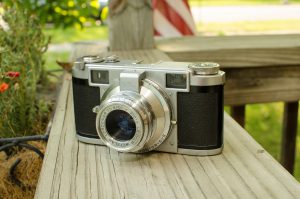












Dear Lordomat Reviewer, I accidentally came across your article about the Lordomat Camera. As you were wondering about the reasons for their short production period, I’d like to put you on http://www.spuer-sinn.net/kamera-geschichten-mit-billigpreis-politik… It’s all in german of course, but in translation it tells the – really tragic- story behind the aprupt end of the Leidolf Company. In short they were dependant on one major client the huge german warehouse chain named ‘Quelle’ particularly its special branch ‘Foto-Quelle’ who forced Leidolf to accept ever increasing low prices over the years. When Leidolf refused to go along with those threads anymore, in 1962 ‘Foto-Quelle’ immediately dropped their orders and that was it. The whole staff had to be released and the owner and constructor of Leidolf Cameras, Wetzlar, Fritz Meinhardt, commited suicide. The ‘Lordomat’ was nicknamed ‘The poor man’s Leica’ from then on which not only in my view was just cynical: The Lordonar had a much quicker filmtransport, a combined rangefinder & composer window and a much cleaner look. (I bought one of the earlier Lordomats with the red window who had a jammed shutter and I flipped through the net for repair hints and I followed a tiny note that I modified: So I took a small coffeeplate and placed the camerabody with the back lid and the lens removed backside down on it. Then I just dropped some lighter fluid / naphta onto the shutter blades and ‘whooosh’ the shutter closed after I don’t know how many years, month, weeks… I repeated the procedure after normal double stroke action and wiping off the fluid carefully and without applying any pressure to the blades.After repeating this four times in 2 days I ended up with a perfect working camera without the need to dissassembling the shutter..) Best regards Peter
Peter, thank you for the link and the story. I didn’t realize that’s how the Leidolf company had come to cease to exist. So sad that it was just due to corporate greed. I agree that the nickname of “Poor Man’s Leica” was unfair. The Lordomat is a wonderful camera that is easy and fun to use, and makes excellent photographs!
Hello,I have leidolf, too.I like it very much. I have a 50mmF1.9 lens for it. It is very prefact lens.
I have two 50mm2.8 in different Styles,and two 35mm3.5in different Styles.
(Comment attempt #2) Hey Mike — your posts have really helped me to decide for/against buying a handful of different vintage cameras. Your test/example photos look great — where/how do you get them scanned? Thanks!
Dana, thanks for the kind words and glad I was able to point you in the right direction. When I first started collecting, I used a couple different online labs like The Darkroom and Dwayne’s Photo, but since 2017, I’ve done all my own developing and scanning at home. My scanner is an Epson V550 and it works fine for my purposes.
Oh yeah — use The Darkroom (despite the time that it takes to send/receive my film from the East Coast to the West Coast) and *generally* their high-res scans are good — but sometimes there are lines/artifacts in the scans. Oh well, one of these days I’ll do it myself I suppose…. Thanks — Dana
Thanks — great quality in the negatives and scans! My biggest frustration with collecting, and wanting to use, vintage cameras are the times when things don’t work. Often the cameras work well mechanically, but the light meters do not function, or are “off” (both Selenium and powered meters). And I’m having bad luck with M42 lenses — shouldn’t that “auto” pin close the aperture to the setting on the aperture ring? On about 1/2 of my M42 “Auto” lenses the aperture stays wide open — if I move the aperture ring to close down the aperture, and then push in the “auto” pin on the lens — no change. But the other 1/2 of my lenses the pin causes the aperture to close to the setting on the aperture ring. Shouldn’t they all do that? If so — how can that be fixed? Thanks!!! –Dana
Hi Dana. We’re going a bit off topic here, but regarding M42 lenses, give both screw threads (lens and body) a good clean and screw the lens in tighter so that the flap on the camera side of the lens mount definitely hits the pin on the lens.
thanks or all your info .. I just bought one with the f1.9 lens. Rangefinder does not work, but lens seems to focus in a rough test with kitchen baking paper. Does anyone have a site that guides me to check on the linkage between lens and rangefinder?
Greg, if you ever find rangefinder adjustment info, please let me know as mine has a bad vertical alignment issue that I’ve never been able to figure out how to correct. German rangefinders like these are often rather tricky to open up!
To adjust the vertical RF: There is a tiny screw locked in place by a nut in the top left hand corner of the light box. Hard to see. The lock is locked with an adhesive. Dissolve the glue, loosen the nut and adjust vertical with small screwdriver. Problem is, I can’t seem to be able to loosen the nut.
Awesome instructions Wes! For so long I tolerated the vertical alignment issues that seem to be so common with Lordomats. I will try this on one of my three models I have and perhaps this will benefit someone else too!
Hi this is Peter, that’s all I found about rangefinder adjustment of the Lordomat: Really not much to do to it as it is almost immaculate. Only need to adjust the rangefinder a little which is easily done by removing the front top cap and adjusting a screw. Quite small but a heavy little sucker. Bottom and back come off for easy loading of the film.
I have a Lordomat bought for me by my son for my 75th birthday. It is in good condition as I had it cla’d. I have put several rolls through it and am delighted with the results. The rangefinder is of the yellow variety and very clear..I note that you think the straplugs were added round about number 100,000, Mine is numbered se-171774 but has no lugs. Is there a way off accurately dating my camera from its number
Sounds like a nice little gift you got yourself. What I like the most about the Lordomats is that for a camera made in Wetzlar, they could have just as easily copied things from Leica, but they didn’t and made a truly unique camera that is just as fun to use (in my opinion of course). Sadly, I’ve found no information about dating these. Most companies did not keep good records of that sort of thing other than Zeiss, Leitz, and Schneider.
I have a Lordomat “Standard” (that’s what I show in my camera inventory — not sure where I found that out!) SN 60209 with a 50mm f2.8 lens. Looks in good shape, but the focus ring is stuck solid and I’m wary to mess with it. So for now it just looks nice on the shelf — but I would love to use it….
Yeah, stuck focus rings suggest the original lube has dried and hardened. The only repair is to open it up, clean off the old stuff and replace it. And if you’re going to open the camera that much, might as well go with a full CLA which could be expensive. Depending on where in the world you are, you might be able to find someone willing to do that for you.
Hey, Mike, Got my Lordomat. Some thoughts: !) spots of corrosion on the base and around the top deck controls, otherwise the exterior is in good condition. 2) lens is in beautiful condition—clear, no scratches and the focus is smooth and easy. I like the clear engravings and markings in feet and meters. Nice click stops. The rangefinder patch is one of the best I have seen, better than any of my other German cameras.3) shutter misbehaved at slow speeds. A little exercise and a little lighter fluid and it sounds in order. 4) The frame counter has the same brass appearance as yours. Still readable. 5) Number is 90455 and has the strap lugs. 6) Only problem was the back would not come off. Finally got it off and found that one side had a warping. Straightened it a bit and it works. 7) The advance is ratcheted. So you do not need to take two full strokes but can do a series of small strokes. 8) Uses 40.5mm accessories on the lens. Easy to find. That’s all for now. Cheers, WES
Very informative…as usual. I was looking up Liedolf cameras because I stumbled upon a Leidolf Automatic Unimark III recently. Like you I had never heard of Leidolf and I was expecting it to have issues, as most German made cameras from this era do. Surprisingly the focus was butter smooth, the shutter works on every speed, the aperture opens and closes without issue…the only issue, though minor, is the winding lever is a bit still…the first wind it sticks a bit, but at the second wind it moves back to the start freely. And as a bonus this model has a non-coupled light meter that appears to still be accurate. I’ve shot a couple of rolls of film through it so far and I’ve been very impressed with the results…very sharp, and nice contrast on B&W film. This particular camera was in a box of cameras a guy I’m acquainted with from FB Market Place bought at a recent auction. He reached out to me and I went to check them out. I left with the Leidolf, an Argus 35 AF, and a Brownie Holiday box camera…all in working order and all for $60.
I might be insane but I just ordered a $35 example to strip the chrome and attempt a repaint myself.